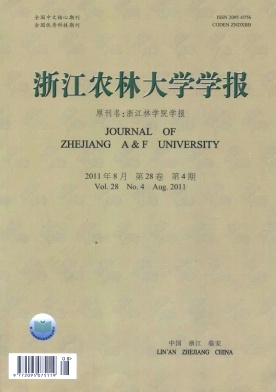| [1] |
YE Bihuan, LI Haibo, YE Weibang, CHEN Youwu.
Sequence analysis of COⅠ, COⅡ, Cytb and 28S gene fragments from Apriona swainsoni larvae
. Journal of Zhejiang A&F University,
2020, 37(2): 303-310.
doi: 10.11833/j.issn.2095-0756.2020.02.015
|
| [2] |
WANG Kai, NIU Shukui.
Research on the potential fire behavior in Jiufeng National Forest Park of Beijing based on the Rothermel Model
. Journal of Zhejiang A&F University,
2016, 33(1): 42-50.
doi: 10.11833/j.issn.2095-0756.2016.01.006
|
| [3] |
SHI Jingjing, ZHANG Chao, YU Shuquan, MAO Shiliang, LI Xiupeng.
Forest fire weather indexes for the fire danger period in Zhejiang Province
. Journal of Zhejiang A&F University,
2014, 31(2): 231-237.
doi: 10.11833/j.issn.2095-0756.2014.02.011
|
| [4] |
FENG Xue, WU Dasheng, LUO Wenjian.
A multi-depot emergency scheduling algorithm for forest fire prevention
. Journal of Zhejiang A&F University,
2013, 30(2): 257-262.
doi: 10.11833/j.issn.2095-0756.2013.02.016
|
| [5] |
JIANG Guangyu, XU Aijun, HUANG Xiaoyin, SHAO Jianlong.
Optimal path algorithm for forest fire prevention with constraints
. Journal of Zhejiang A&F University,
2013, 30(1): 76-82.
doi: 10.11833/j.issn.2095-0756.2013.01.011
|
| [6] |
QIN Fei-fei, TANG Li-hua.
Study on synchronization tracking algorithm in remote video monitoring of forest fires based on DEM
. Journal of Zhejiang A&F University,
2012, 29(6): 917-922.
doi: 10.11833/j.issn.2095-0756.2012.06.017
|
| [7] |
XU Ai-jun, HUANG Xiao-yin, JIANG Guang-yu, SHAO Jian-long.
Precision fire hazard divisions for collective forest in southern China
. Journal of Zhejiang A&F University,
2012, 29(1): 65-71.
doi: 10.11833/j.issn.2095-0756.2012.01.012
|
| [8] |
XIN Xiao-ying, JIANG Hong, ZHOU Guo-mo, YU Shu-quan, WANG Yong-he.
Canadian forest fire weather index (FWI) system:a review
. Journal of Zhejiang A&F University,
2011, 28(2): 314-318.
doi: 10.11833/j.issn.2095-0756.2011.02.023
|
| [9] |
JU Yun-wei, FAN Pei-feng, XI Yue-ming, XUE Zhong-guan.
Marigold (Tagetes erecta) extracts to kill Bursaphelenchus xylophilus
. Journal of Zhejiang A&F University,
2010, 27(2): 316-319.
doi: 10.11833/j.issn.2095-0756.2010.02.026
|
| [10] |
QIU Jin-hong, SHEN Ming-xia, CONG Jing-hua, LI Long-guo.
Monocular vision technique based real-time location of fire-point in forest
. Journal of Zhejiang A&F University,
2010, 27(5): 651-658.
doi: 10.11833/j.issn.2095-0756.2010.05.003
|
| [11] |
XU Hua-chao, LUO You-qing.
Ecosystems attacked by Bursaphelenchus xylophilus:a review
. Journal of Zhejiang A&F University,
2010, 27(3): 445-450.
doi: 10.11833/j.issn.2095-0756.2010.03.020
|
| [12] |
MA Liang-jin, WU Mei-qing, SU Xiu, CHEN An-liang, ZHANG Li-qin.
Antifungal activity in vitro with extracts from the husk of Carya cathayensis
. Journal of Zhejiang A&F University,
2009, 26(5): 620-624.
|
| [13] |
LI Shi-you, LUO Wen-biao, SHU Qing-tai, MA Chang-le, MA Ai-li, ZHANG Qiao-rong.
Combustibility of 25 woody plants for selection of fire-resistant tree species in Kunming area
. Journal of Zhejiang A&F University,
2009, 26(3): 351-357.
|
| [14] |
XIA Qi-biao, LI Guang-hui, YIN Jian-xin.
Application of percolation theory in forest fire simulation
. Journal of Zhejiang A&F University,
2009, 26(2): 233-238.
|
| [15] |
SU Xiu, MA Liang-jin, CHEN An-liang, ZHANG Li-qin.
Antifungal and antibacterial activity of extracts from the husk of Carya cathayensis
. Journal of Zhejiang A&F University,
2008, 25(3): 355-358.
|
| [16] |
MAO Sheng-feng, ZHANG Li-qin, ZHANG Jian, LIN Hai-ping, MA Liang-jin, XU Qing-xin.
Antimicrobial activity of extracts from Pinus massoniana needles
. Journal of Zhejiang A&F University,
2008, 25(3): 359-362.
|
| [17] |
CHEN Pei-jin, XU Ai-jun, SHAO Xiang-jun, LIU Ai-jun.
Design and implementation of GIS-based forest fire assessment algorithm
. Journal of Zhejiang A&F University,
2008, 25(1): 72-77.
|
| [18] |
LOU Xiong-wei, FANG Lu-ming, XU Ai-jun, YE Xiang-gen.
Data fusion with 3D modeling for forest fire prevention background database
. Journal of Zhejiang A&F University,
2008, 25(4): 405-410.
|
| [19] |
LI Lan-ying, GAO Lan, WEN Ya-li, HUANG Shui-ling.
Countermeasures and environmental influence analysis of forest diseases
. Journal of Zhejiang A&F University,
2006, 23(5): 491-496.
|
| [20] |
LI Tu-sheng, YANG You-ping, JIA Wei-jiang, WENG Wei-song, WAN Tong-xin, HUA Jun-jian.
Designing and development of geographic information system for preventing forest fire in Zhejiang
. Journal of Zhejiang A&F University,
2002, 19(3): 273-276.
|







 DownLoad:
DownLoad: